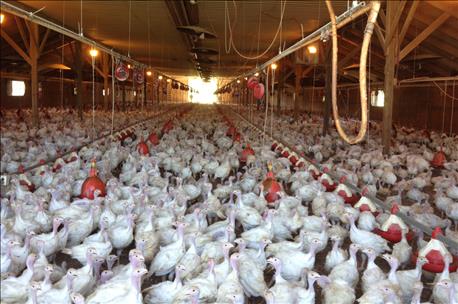
The premise identification program wasn’t popular with everyone when the Indiana State Board of Animal Health implemented it years ago. The program, called premID, requires anyone buying, selling or exhibiting livestock, including cattle, sheep, goats, swine and farmed cervids, to record the location of those animals with BOAH. Even the location where 4-H animals are kept must be reported.

COMMERCE CONTINUED: With the help of premise identification, around the clock testing and state permits, products moved in and out during the quarantine outbreak in Indiana in January. (Photo courtesy of Minnesota Turkey Growers Association)
Purdue University Extension aided with the process. Ironically, it was mandatory for all livestock except poultry. Registration of premise identification location for poultry was voluntary, and still is. Fortunately, the commercial poultry industry foresaw the value of premise identification and had premIDs for their farms.
The recent outbreak of avian flu in turkeys in Indiana earlier this year makes the case for why premise identification is so important.
“We also use it to help trace movement of animals into and out of the state,” Denise Derrer of BOAH explains. “Those movements, along with individual animal identification, are reflected on certificates of veterinary inspection. From time to time, another state will have an animal test positive for something, and we need to determine if, when and where it came through Indiana.”
If an infected animal did pass through Indiana, it may mean testing others in the state,” she says. “This actually happens often but rarely makes the news,” she notes.
Premise ID and avian flu outbreak
However, the avian flu outbreak in January splashed across the news everywhere. Derrer lays out the timeline, and how premise identification helped officials contain the threat.
Mid-January- first positive case of avian flu reported to BOAH.
“Upon notification BOAH was able to use mapping software to identify all commercial and private or small flocks, if they were registered, within a 6.2 mile circle of the infected site,”Derrer explains. The 6.2 mile circle corresponds with a 10 kilometer area mandated by USDA. All flocks within the circle had to be tested.
Hours after first report- BOAH began testing.
Because commercial flocks were pre-identified, all 65 flocks in the control area were located quickly. Testing began within hours of the index case being reported, Derrer says.
Within 24 hours- more flocks tested positive.
Testing identified nine more flocks that were positive, Derrer says. That allowed BOAH to start quarantine and response procedures on those additional farms quickly. “This speaks to how the premID system helps us respond quickly,” she notes. “It’s an important factor in containment of disease.” In contrast, reaction wasn’t as fast in Iowa and Minnesota in 2015 when avian flu broke in flocks. They don’t have a traceability system like Indiana,” Derrer says.
Within first week- permits were issued so farms within the control area could move birds and/or products such as eggs.
“Those premID’s were important to farms in the control area, because any movement of birds or eggs had to be done with a permit issued by BOAH,” Derrer says. “A permit could be obtained only after a negative avian influenza test was completed within 24 hours (of movement).”
The premID system helped track test results, with hundreds going through the lab on some days, Derrer adds.
Days and weeks following outbreak- Products keep moving from flocks testing negative.
Products could continue moving from non-infected farms with testing and permits. “That kept farms in business and helped support the local economy,” Derrer observes. The alternative would have been shutting everything down. During the 38 days where the quarantine was in place within the control area, 738 movement permits were issued.
During weeks of quarantine - what could have happened would have been devastating.
“Without premise ID, commerce would have come to a standstill,” Derrer says. “We would have literally had to drive all the roads and notify all the infected farms in the control area. The permit process would also have been slowed and perhaps confused, because tracking farms by owners’ names can get confusing and may be inaccurate.”
During the quarantine - PremID helped track down small flocks
BOAH also used the premID system to track backyard flocks in the control area, Derrer says. Most had to be identified, which took more time, since poultry registration is voluntary. Once the flocks were identified BOAH assigned them a premID.
Postscript- How it worked
Being able to map premises immediately helped BOAH plan staffing and resources, Derrer says. Within minutes BOAH knew how many farms they were dealing with, and started scheduling staff, and working with USDA to make sure enough responders would be on the scene.
In addition, BOAH’s database for premised identification is organized and searchable by ID number, Derrer says. That helps staff be more efficient in case management, mapping and other tasks associated with a disease investigation, Derrer concludes.
About the Author(s)
You May Also Like




